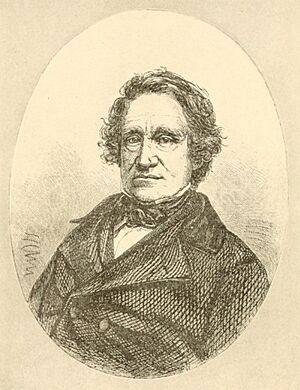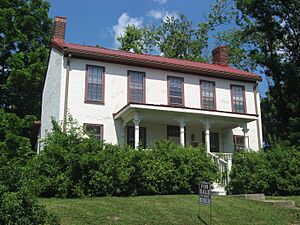Baynard Rush Hall facts for kids
Baynard Rush Hall (1793-1863) was an American teacher and a Christian minister. He was born in Pennsylvania. For most of his life, he worked at churches and schools in the eastern United States. However, he lived in Indiana for several years. During this time, he became the very first teacher at what is now Indiana University.
Contents
A New Teacher in Indiana
Baynard Rush Hall was born in Philadelphia in 1793. He went to Union College and Princeton Theological Seminary. After his studies, he became a Presbyterian minister. Before college, he worked as a printer. He learned about opportunities in the "Western United States" (which was Indiana back then).
In 1823, Hall moved his family to southern Indiana. He lived with relatives for a year near Gosport. He also preached sometimes. In 1825, he was chosen to be the first teacher at the Indiana State Seminary in Bloomington. This school was founded in 1820 but had not yet opened.
For two years, starting in 1825, Hall taught all the classes. These classes mostly focused on Greek and Latin languages. In the first year, he taught twelve students. He earned $250 and goods worth $150 for preaching. Hall believed that studying old languages and ideas was the best way to learn.
Changes at the School
Between 1827 and 1829, the school changed a lot. John Hopkins Harney from Kentucky was hired to teach science and mathematics. In 1828, the state government changed the school's name to "Indiana College." One year later, Andrew Wylie became the first president.
Wylie, like Hall, was a Presbyterian minister. Harney was also a Presbyterian. Many local people complained about this. They felt that one teacher was enough for the school. When they learned about Harney's religion, many non-Presbyterians protested. Hiring another Presbyterian as president caused more anger. People accused the school's leaders of favoring one religion. Even though the leaders were from six different churches, the complaints continued.
Soon, there were disagreements among the three teachers. Harney was dismissed, and Hall resigned. Hall moved back to the East. He continued to work as a teacher and religious leader until he passed away.
Life in Indiana
Hall found his time in Indiana challenging. He felt like an educated person from the East in a place where many people could not read or write. Legend says he brought the first piano to Bloomington. He also believed he was the first person in Indiana to understand Ancient Greek.
Local people, in turn, were suspicious of the school and its educated staff. However, Hall did become friends with Austin Seward, a local craftsman and blacksmith. Hall later wrote about pioneer life in Bloomington. He praised Seward's skills and artistic talents. In the end, Hall was determined to feel like a true "Hoosier" (a person from Indiana).
His Books
After returning to the East, Hall published several books before he died in 1863. One book was called The New Purchase. It told stories about pioneer life in Indiana. Hall changed some names and places in the book, which caused some confusion. However, a famous Indiana historian, David Banta, said The New Purchase was the best account of pioneer life in Indiana.
Another book he wrote was Frank Freeman's Barber Shop. It was published in 1852. This book was written as a different view to Uncle Tom's Cabin.
Hall's House Today
Hall's house in Bloomington was built in 1835. It is still standing today in the city's McDoel Gardens neighborhood. It is the oldest building still standing in that area.



